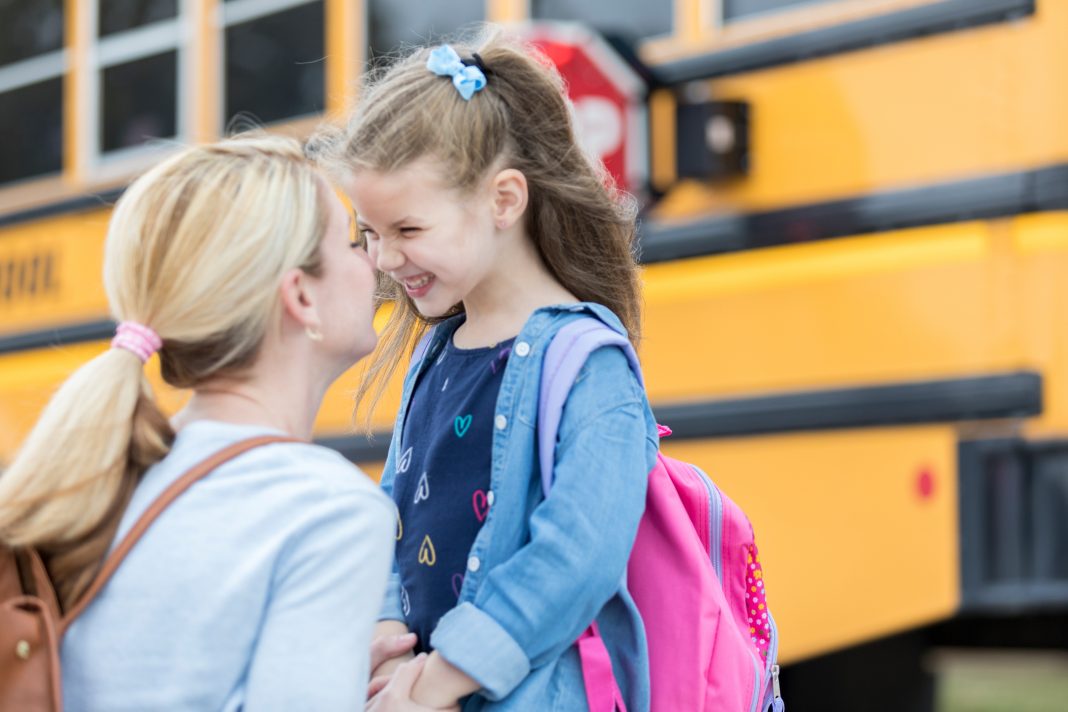School is here again and it is time to dust off the backpacks, find the hidden lunchboxes and get to bed early so you can make it out the door on time! This is no small feat for many of us parents, and creating a school morning routine can feel overwhelming at best.

Let me share with you my go-to tool for establishing a morning routine in your home that will allow you and your child to leave the house with greater ease (yes, that is right, mornings don’t have to be so stressful). I will also share a few ways you can practice and establish this new back-to-school routine for the beginning of this new school year!
Why Choose a Morning Routine
Creating a morning routine with your child offers many benefits for the short-term goal of getting out the door with less stress. The morning routine also has the added long-term benefit of your child working together as a family team, learning how to follow through with a plan, and practicing time management skills. Although your child may not know they are learning these long-term goals at the time, you will notice that as they grow older, your child embodies these long-term benefits because of all the practice they are getting each morning.
How to Implement a Morning Routine in Your Home
To begin, you will want to create your morning routine with your child! This is very important because if you are creating the routine alone, then it becomes your morning routine and NOT your child’s morning routine. Think of it as having your boss hand you a to-do list for the day rather than you creating a list of the tasks that need to be done at work. How would you feel after your boss left you with your list? Would you want to participate or feel resentful? What if instead of handing you a list of tasks for the day, your boss sat down with you and asked you what you needed to get done that day? What if your boss helped you create a list that was doable and fun?! I bet that would feel a lot better and you would be more motivated for your day at work. Children feel the same way when they are constantly being told what to do. A child can feel overwhelmed (especially early in the morning and when the clock is ticking to get out the door). So, let’s make the school morning routine fun and collaborative!
To begin, carve out some time to sit with your child and discuss what the morning routine will look like. You might start the conversation by asking, “What do we need to do to get ready for school in the morning?” Your young child may share a few helpful things they do in the mornings, such as eating breakfast and getting dressed. You can then help guide the list by adding things that may have been missed. In this example, brushing hair and teeth can be added.
After you have created a list of what will go on the morning routine chart, create your very own poster using the agreed upon items that your child will do in the morning. For young children, I suggest taking pictures of them doing each item on their list and gluing them on their poster so that they can visually see what is on their chart. This is a great first step in helping younger aged children see how they can get ready in the morning and learn this important process that will serve them for years to come.
For older children, they may want to write their own morning routine on the poster or make it a list on paper, draw pictures, print images from a computer, or type up their morning routine. Let your child’s age and interests guide how they make their morning routine special to them.
Of course, there will still be difficult mornings where a child doesn’t want to do everything on their list, but you will be amazed by how much smoother getting out the door is as you help your child learn to follow the steps outlined on their poster. The days of hectic mornings and reactive parenting moments are far and few between now that my children have been practicing their morning routine for so many years!
Practice Time!
Is your child feeling anxious about the start of school or unsure of their morning routine? Are you looking for ways to practice their new skill? If so, pretend play is the way to go! Plus, it gives kids a chance to express their feelings and problem-solve any unforeseen hiccups in the plan they made. Set aside time before school starts to practice going back to school. For younger children (and children who are feeling nervous), you may do this practice with dolls, toys and stuffed animals. Once school starts, you can continue this type of play. Let your child take the lead and notice how they share their worries through their pretend play. As their fears come up, you can offer tools and support (just be sure you do it in your best stuffed animal voice and keep it fun!).
For older children or children who are not feeling nervous about the start of the year, you can go through the morning routine a day or two before school starts to make sure they have the hang of the routine.





















